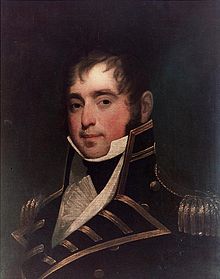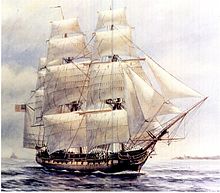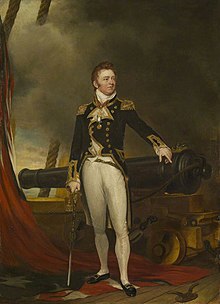Capture of USS Chesapeake
The battle was notably intense but of short duration, lasting ten to fifteen minutes, in which time 226 men were killed or wounded.
Chesapeake and her crew were taken to Halifax, Nova Scotia, where the sailors were taken to prisoner-of-war camps; the ship was repaired and taken into service by the Royal Navy.
During his long period in command of Shannon, Captain Philip Broke of the Royal Navy introduced many practical refinements to his 'great guns', which were virtually unheard of elsewhere in contemporary naval gunnery.
As the decks of contemporary ships curved upwards towards the stern and bows, he cut down the wheels on the "up-slope" side of each cannon's carriage in order that all guns were level with the horizon.
[2] Broke drilled his crew to an extremely high standard of naval gunnery; he regularly had them fire at targets, such as floating barrels.
This was a game employing roughly similar cuts, thrusts and parries as were used with the cutlass, but as it was played with wooden sticks with wicker hand guards; hits, although painful, were not often dangerous.
[4][5] Commander Lawrence of the United States Navy returned from a successful war cruise having defeated the sloop HMS Peacock.
Eager to engage and defeat one of the American frigates that had already scored a number of victories over the Royal Navy in single-ship confrontations, Broke prepared a challenge.
Consequently, Broke decided to challenge Chesapeake, which had been refitting in Boston harbour under the command of Captain James Lawrence, offering single ship-to-ship combat.
Broke therefore resorted to burning the rest of the prizes in order to conserve his highly trained crew in anticipation of the battle with Chesapeake.
In the short time he was in command of the Chesapeake, Lawrence had twice exercised his crew at the great guns, walking the decks and personally supervising the drill.
[15] HMS Shannon had been off Boston for 56 days and was running short of provisions, whilst the extended period at sea was wearing the ship down.
Shannon was flying a weather-worn blue ensign, and her dilapidated outside appearance after a long period at sea suggested that she would be an easy opponent.
[35] Losing her forward momentum, she yawed further into the wind until she was 'in irons', her sails were pressed back against her masts and she then made sternway (went backwards).
Lieutenant Cox, who had brought up men from the lower deck to form a boarding party, reached the quarterdeck only to find that his captain had been badly, indeed mortally, wounded by musket fire.
Captain Broke, at the head of not more than twenty men, stepped from the rail of the hammock netting onto the muzzle of the port-side carronade of Chesapeake closest to the stern, and from there he jumped down to her quarterdeck.
Two American officers, Lieutenant Cox (who had returned from carrying Captain Lawrence down to the surgeon) and Midshipman Russell saw that the aftmost 18-pounders on the port side still bore on Shannon.
[37] Lieutenant Ludlow, who had been slightly wounded and had gone down to Chesapeake's cockpit for treatment, now returned to the upper decks, rallying some of the American crew as he did so.
James Bulger, one of Shannon's Irishmen, charged into the Americans wielding a boarding pike and shouting Gaelic curses – "And then did I not spit them, beJaysus!"
"[41] Fighting had also been ongoing between the tops (platforms at the junction of mast and topmast) of the ships, as rival sharpshooters fired upon their opponents and upon sailors on the exposed decks below.
Taken by surprise, he killed the first, but the second hit him with a musket which stunned him, whilst the third sliced open his skull with a sabre or cutlass, knocking him to the deck.
The desperate and violent attempt on Broke's life made by these men may have been motivated by the fact that they faced the death penalty under the Royal Navy's Articles of War as deserters.
Lieutenant Charles Leslie Falkiner of Shannon, the leader of the boarders who had rushed the maindeck, restored order by threatening to blow out the brains of the next person to fire.
Shortly after Chesapeake had been secured, Broke fainted from loss of blood and was rowed back to Shannon to be attended to by the ship's surgeon.
[49] Some British sailors alleged the intention was to throw handfuls into the eyes of Shannon's men in an unfair and dishonourable manner as they attempted to board, though that was never done by Chesapeake's crew.
He had some of the leaders of the unrest transferred to Shannon in the leg-irons that had, ironically, been shipped aboard Chesapeake to deal with expected British prisoners.
The rest of the American crew were rendered docile by the expedient of a carpenter cutting scuttles (holes) in the maindeck through which two 18-pounder cannon, loaded with grapeshot, were pointed at them.
Therapeutic bleeding, routinely employed at the time, was not performed by Shannon's surgeon Mr Alexander Jack, which was to Broke's advantage.
Shannon's bell is displayed at the Maritime Museum of the Atlantic in Halifax in an exhibit about the battle which includes a surgeon's chest and mess kettle from Chesapeake.
[68] The capture of USS Chesapeake by HMS Shannon features prominently in The Fortune of War, the sixth book in the Aubrey–Maturin series of historical fiction novels by Patrick O'Brian, and first published in 1979.













